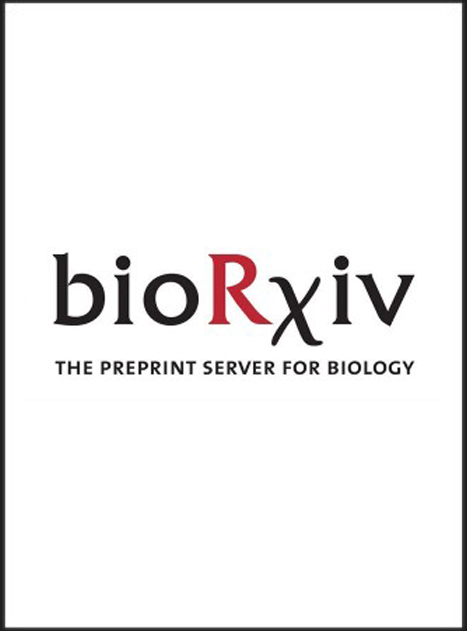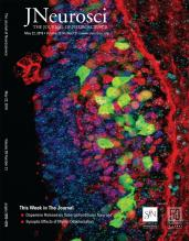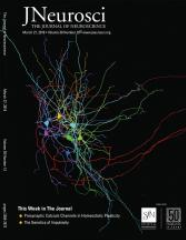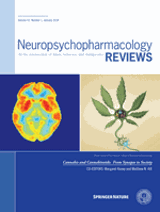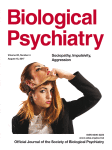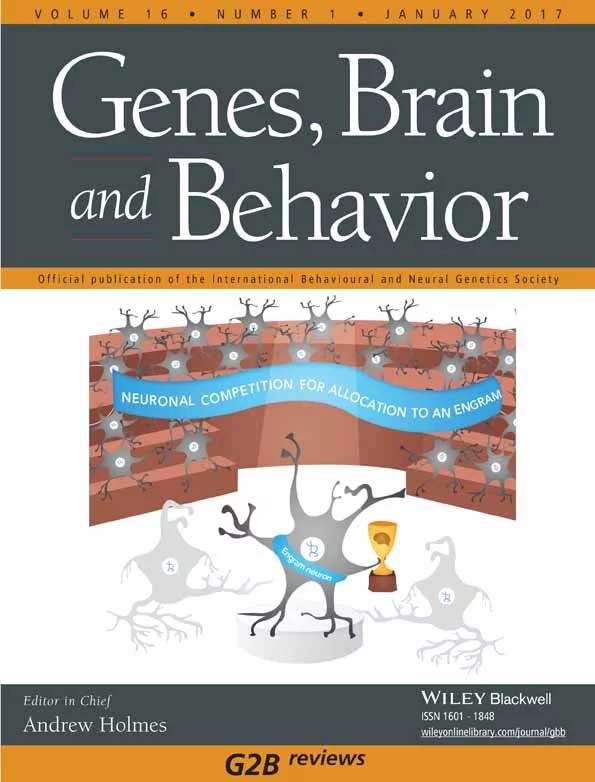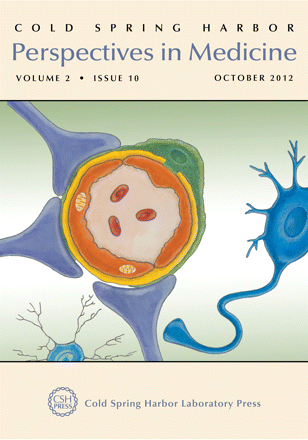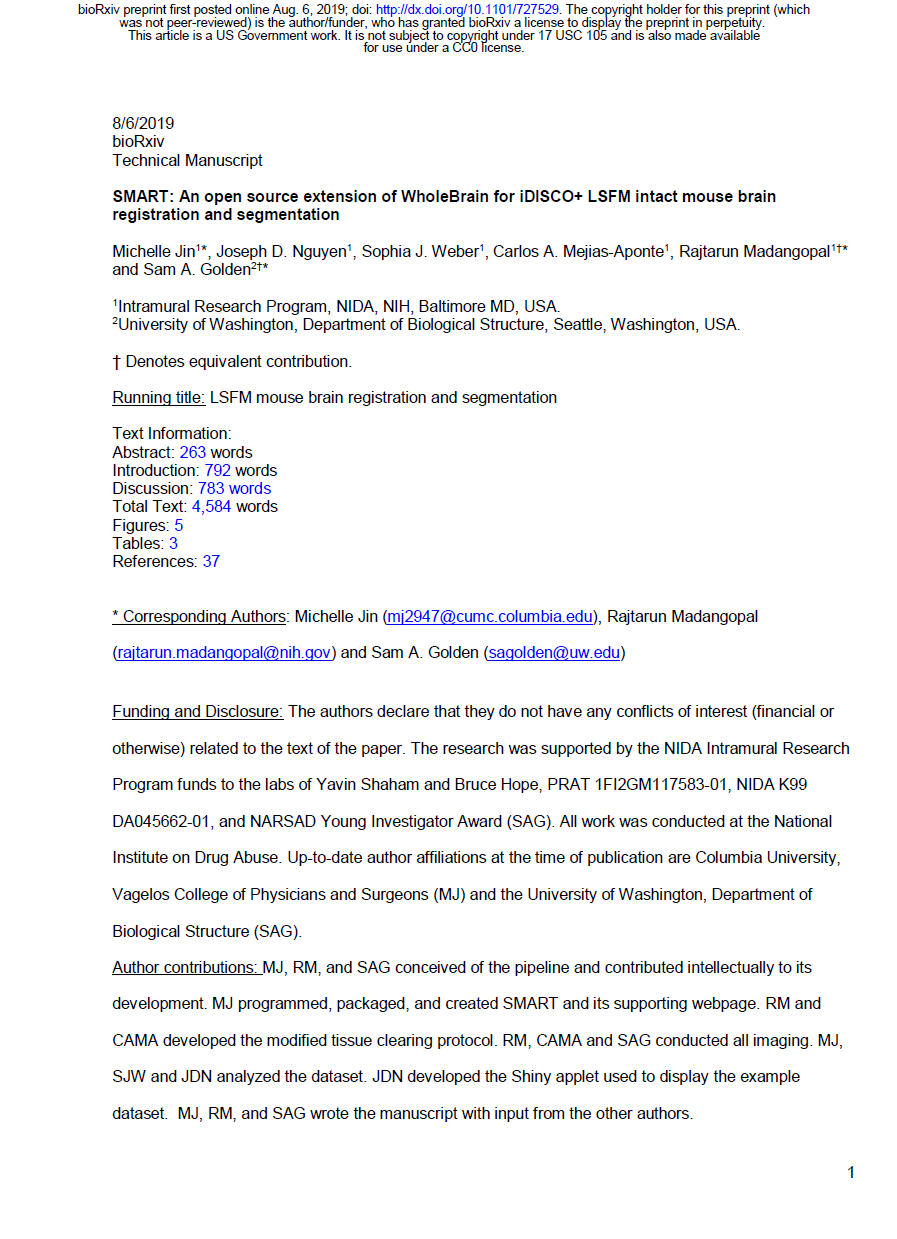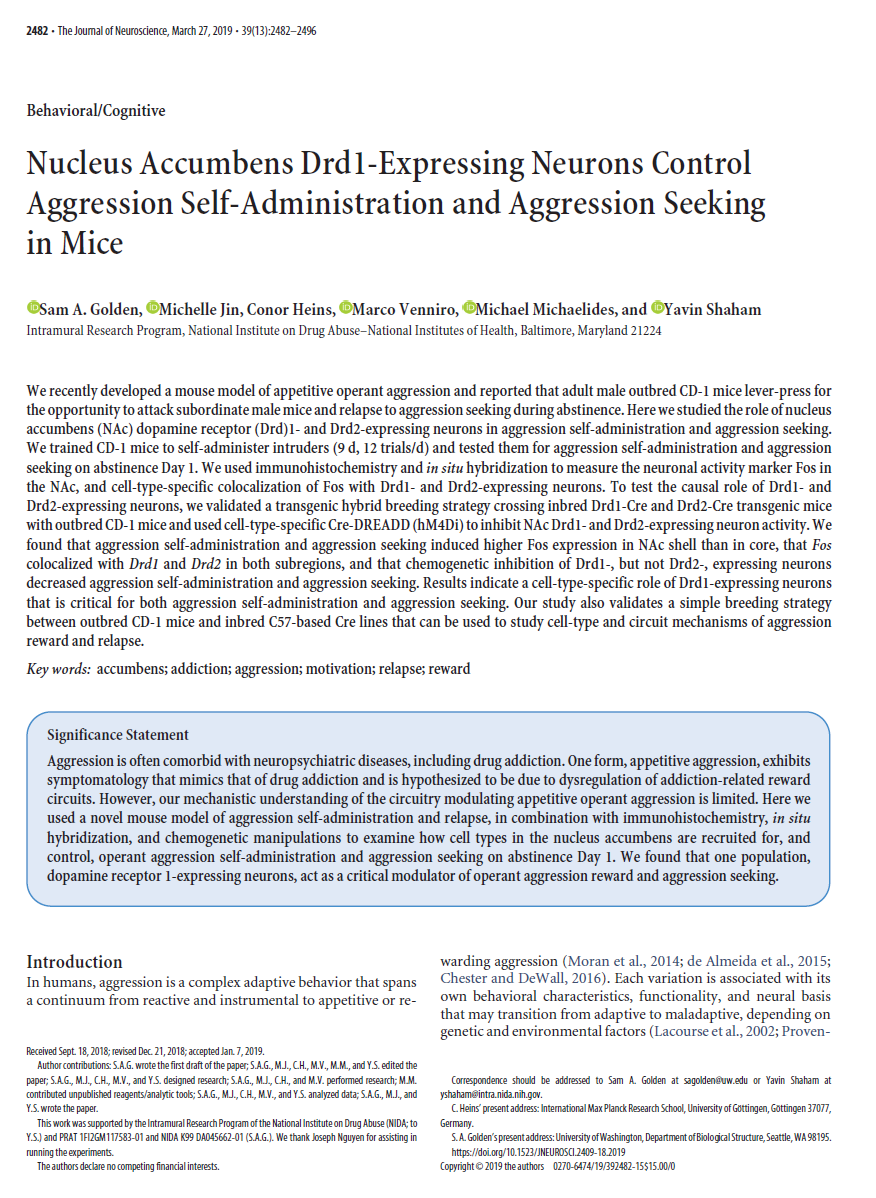Publications
Select Publications
Cover images from selected published manuscripts, select to jump to manuscript in list below. Full PDFs provided.
SMART: An open source extension of WholeBrain for iDISCO+ LSFM intact mouse brain registration and segmentation
bioRxiv. 2019 August 6. doi: 10.1101/727529
Jin M, Nguyen JD, Weber SJ, Mejias-Aponte CA, Madangopal R, Golden SA.
Mapping immediate early gene (IEG) expression across intact brains is becoming a popular approach for identifying the brain-wide activity patterns underlying behavior. Registering whole brains to an anatomical atlas presents a technical challenge that has predominantly been tackled using automated voxel-based registration methods; however, these methods may fail when brains are damaged or only partially imaged, can be challenging to correct, and require substantial computational power. Here we present an open source package in R called SMART (semi-manual alignment to reference templates) as an extension to the WholeBrain framework for automated segmentation and semi-automated registration of experimental images to vectorized atlas plates from the Allen Brain Institute Mouse Common Coordinate Framework (CCF).
The SMART package was created with the novice programmer in mind and introduces a streamlined pipeline for aligning, registering, and segmenting large LSFM volumetric datasets with the CCF across the anterior-posterior axis, using a simple ‘choice game’ and interactive user-friendly menus. SMART further provides the flexibility to register partial brains or discrete user-chosen experimental images across the CCF, making it compatible with analysis of traditionally sectioned coronal brain slices. In addition to SMART, we introduce a modified tissue clearing protocol based on the iDISCO+ procedure that is optimized for uniform Fos antibody labeling and tissue clearing across whole intact mouse brains. Here we demonstrate the utility of the SMART-WholeBrain pipeline, in conjunction with the modified iDISCO+ Fos procedure, by providing example datasets alongside a full user tutorial. Finally, we present a subset of these data online in an interactive web applet. The complete SMART package is available for download on GitHub.
Animal Models of (or for) Aggression Reward, Addiction, and Relapse: Behavior and Circuits
The Journal of Neuroscience. 2019 May 22;39(21):3996-4008. doi: 10.1523/JNEUROSCI.0151-19.2019.
Golden SA, Jin M, Shaham Y.
Inappropriate and pathological aggression plays a leading role in the suffering and death of millions of people, and further places an untenable strain on the caregivers and families of those afflicted. In some cases, such as addictive drugs, aggression can be highly rewarding (appetitive) and continually pursued despite short- and long-term negative consequences. Similarly, recidivism (relapse) rates for repeat violent offenders are as high as relapse rates for drug addicts. Appetitive aggression and relapse to aggression seeking can be modeled in mice studies using conditioned place preference and self-administration procedures followed by a period of abstinence and subsequent tests for relapse to aggression preference and aggression seeking. These procedures allow for the study of the mechanisms that control the appetitive versus the consummatory (attack) phases of aggressive behavior. In this review, we first discuss the behavioral procedures developed to probe appetitive aggression in mouse models, spanning from Pavlovian to operant tasks, and we also describe the recently proposed phenomenon of “aggression addiction.” Next, we discuss the pharmacological and circuit mechanisms of aggression conditioned place preference and aggression self-administration, seeking, and relapse, highlighting mechanistic congruence and divergence between appetitive and consummatory phases of aggression. We conclude by discussing clinical implications of the studies reviewed.
Nucleus Accumbens Drd1-Expressing Neurons Control Aggression Self-Administration and Aggression Seeking in Mice.
The Journal of Neuroscience. 2019 Mar 27;39(13):2482-2496. doi: 10.1523/JNEUROSCI.2409-18.2019.
Golden SA, Jin M, Heins C, Venniro M, Shaham Y.
We recently developed a mouse model of appetitive operant aggression and reported that adult male outbred CD-1 mice lever-press for the opportunity to attack subordinate male mice and relapse to aggression seeking during abstinence. Here we studied the role of nucleus accumbens (NAc) dopamine receptor (Drd)1- and Drd2-expressing neurons in aggression self-administration and aggression seeking. We trained CD-1 mice to self-administer intruders (9 d, 12 trials/d) and tested them for aggression self-administration and aggression seeking on abstinence Day 1. We used immunohistochemistry and in situ hybridization to measure the neuronal activity marker Fos in the NAc, and cell-type-specific colocalization of Fos with Drd1- and Drd2-expressing neurons. To test the causal role of Drd1- and Drd2-expressing neurons, we validated a transgenic hybrid breeding strategy crossing inbred Drd1-Cre and Drd2-Cre transgenic mice with outbred CD-1 mice and used cell-type-specific Cre-DREADD (hM4Di) to inhibit NAc Drd1- and Drd2-expressing neuron activity. We found that aggression self-administration and aggression seeking induced higher Fos expression in NAc shell than in core, that Fos colocalized with Drd1 and Drd2 in both subregions, and that chemogenetic inhibition of Drd1-, but not Drd2-, expressing neurons decreased aggression self-administration and aggression seeking. Results indicate a cell-type-specific role of Drd1-expressing neurons that is critical for both aggression self-administration and aggression seeking. Our study also validates a simple breeding strategy between outbred CD-1 mice and inbred C57-based Cre lines that can be used to study cell-type and circuit mechanisms of aggression reward and relapse.
Aggression Addiction and Relapse: A New Frontier in Psychiatry.
Neuropsychopharmacology. 2018 Jan;43(1):224-225. doi: 10.1038/npp.2017.173.
Golden SA, Shaham Y.
There is an increased risk for abnormal or pathological aggression in individuals suffering from psychiatric disorders. Aggression is commonly ethologically demarcated as either appetitive or reactive, each with its own behavioral characteristics, functionality, and neural basis that may transition from adaptive to maladaptive depending on genetic and environmental factors. One type, pathological appetitive aggression, is hypothesized to result from excessive activation of evolutionary conserved reward circuits, which also mediate the rewarding effects of addictive drugs. Indeed, inappropriate appetitive aggression shows core features of addiction: aggression is often sought despite immediate or long-term adverse consequences, and relapse (recidivism) rates among violent offenders are as high as relapse rates in drug addiction. Despite these similarities, pathological aggression seeking has not been commonly incorporated into the conceptual framework of addiction and psychiatric disorders. Such a reconceptualization may positively impact therapeutic strategies to prevent pathological aggression and decrease recidivism (relapse) rates after incarceration or inpatient treatment.
Combinatorial Psycho-Pharmacological Approaches for the Treatment of Abnormal Aggression.
Neuropsychopharmacology. 2018 Jan;43(2):233-234. doi: 10.1038/npp.2017.174.
Golden SA, Takahashi A.
Aggression is a highly evolutionarily adaptive behavior that is critical for survival and reproduction, and therefore, strongly ethologically conserved across species. However, due to environmental or biological processes, aggressive behavior can transition from adaptive to maladaptive. This transition is associated with detrimental outcomes for both the individual exhibiting the behavior and their victims. Within the United States, an estimated 2.7 million individuals over the age of 12 report experiencing one or more violent victimizations annually (Truman and Morgan, 2016), and ~70% of victims of serious violence experience ongoing socio-emotional problems as a direct result (Langton and Truman, 2014). Due to the marked impact violence has on societal health and well-being, there have been efforts to identify the underlying risk factors associated with the development of abnormal aggression. Longitudinal prospective population-based studies have consistently associated future violence and crime with early-life adversities such as abuse or neglect. Strikingly, early-life neglect is one of the most damaging predisposing factors, even more so than inter-personal violence and physical or sexual abuse (Gilbert et al., 2009).
Compulsive Addiction-like Aggressive Behavior in Mice.
Biol Psychiatry. 2017 Aug 15;82(4):239-248. doi: 10.1016/j.biopsych.2017.03.004.
Golden SA, Heins C, Venniro M, Caprioli D, Zhang M, Epstein DH, Shaham Y.
BACKGROUND: Some people are highly motivated to seek aggressive encounters, and among those who have been incarcerated for such behavior, recidivism rates are high. These observations echo two core features of drug addiction: high motivation to seek addictive substances, despite adverse consequences, and high relapse rates. Here we used established rodent models of drug addiction to determine whether they would be sensitive to "addiction-like" features of aggression in CD-1 mice. METHODS: In experiments 1 and 2, we trained older CD-1 mice to lever press for opportunities to attack younger C57BL6/J mice. We then tested them for relapse to aggression seeking after forced abstinence or punishment-induced suppression of aggression self-administration. In experiment 3, we trained a large cohort of CD-1 mice and tested them for choice-based voluntary suppression of aggression seeking, relapse to aggression seeking, progressive ratio responding, and punishment-induced suppression of aggression self-administration. We then used cluster analysis to identify patterns of individual differences in compulsive "addiction-like" aggressive behavior. RESULTS: In experiments 1 and 2, we observed strong motivation to acquire operant self-administration of opportunities to aggress and relapse vulnerability during abstinence. In experiment 3, cluster analysis of the aggression-related measures identified a subset of "addicted" mice (∼19%) that exhibited intense operant-reinforced attack behavior, decreased likelihood to select an alternative reinforcer over aggression, heightened relapse vulnerability and progressive ratio responding, and resilience to punishment-induced suppression of aggressive behavior. CONCLUSIONS: Using procedures established to model drug addiction, we showed that a subpopulation of CD-1 mice demonstrate "addiction-like" aggressive behavior, suggesting an evolutionary origin for compulsive aggression.
Persistent conditioned place preference to aggression experience in adult male sexually-experienced CD-1 mice.
Genes Brain Behav. 2017 Jan;16(1):44-55. doi: 10.1111/gbb.12310.
Golden SA*, Aleyasin H*, Heins R, Flanigan M, Heshmati M, Takahashi A, Russo SJ, Shaham Y.
We recently developed a conditioned place preference (CPP) procedure, commonly used to study rewarding drug effects, to demonstrate that dominant sexually-experienced CD-1 male mice form CPP to contexts previously associated with defeating subordinate male C57BL/6J mice. Here we further characterized conditioned and unconditioned aggression behavior in CD-1 mice. In Exp. 1 we used CD-1 mice that displayed a variable spectrum of unconditioned aggressive behavior toward younger subordinate C57BL/6J intruder mice. We then trained the CD-1 mice in the CPP procedure where one context was intruder-paired, while a different context was not. We then tested for aggression CPP 1 day after training. In Exp. 2, we tested CD-1 mice for aggression CPP 1 day and 18 days after training. In Exp. 3-4, we trained the CD-1 mice to lever-press for palatable food and tested them for footshock punishment-induced suppression of food-reinforced responding. In Exp. 5, we characterized unconditioned aggression in hybrid CD-1 × C57BL/6J D1-Cre or D2-Cre F1 generation crosses. Persistent aggression CPP was observed in CD-1 mice that either immediately attacked C57BL/6J mice during all screening sessions or mice that gradually developed aggressive behavior during the screening phase. In contrast, CD-1 mice that did not attack the C57BL/6J mice during screening did not develop CPP to contexts previously paired with C57BL/6J mice. The aggressive phenotype did not predict resistance to punishment-induced suppression of food-reinforced responding. CD-1 × D1-Cre or D2-Cre F1 transgenic mice showed strong unconditioned aggression. Our study demonstrates that aggression experience causes persistent CPP and introduces transgenic mice for circuit studies of aggression.
Basal forebrain projections to the lateral habenula modulate aggression reward.
Nature. 2016 Jun 30;534(7609):688-92. doi: 10.1038/nature18601.
Golden SA, Heshmati M, Flanigan M, Christoffel DJ, Guise K, Pfau ML, Aleyasin H, Menard C, Zhang H, Hodes GE, Bregman D, Khibnik L, Tai J, Rebusi N, Krawitz B, Chaudhury D, Walsh JJ, Han MH, Shapiro ML, Russo SJ.
Maladaptive aggressive behaviour is associated with a number of neuropsychiatric disorders and is thought to result partly from the inappropriate activation of brain reward systems in response to aggressive or violent social stimuli. Nuclei within the ventromedial hypothalamus, extended amygdala and limbic circuits are known to encode initiation of aggression; however, little is known about the neural mechanisms that directly modulate the motivational component of aggressive behaviour. Here we established a mouse model to measure the valence of aggressive inter-male social interaction with a smaller subordinate intruder as reinforcement for the development of conditioned place preference (CPP). Aggressors develop a CPP, whereas non-aggressors develop a conditioned place aversion to the intruder-paired context. Furthermore, we identify a functional GABAergic projection from the basal forebrain (BF) to the lateral habenula (lHb) that bi-directionally controls the valence of aggressive interactions. Circuit-specific silencing of GABAergic BF-lHb terminals of aggressors with halorhodopsin (NpHR3.0) increases lHb neuronal firing and abolishes CPP to the intruder-paired context. Activation of GABAergic BF-lHb terminals of non-aggressors with channelrhodopsin (ChR2) decreases lHb neuronal firing and promotes CPP to the intruder-paired context. Finally, we show that altering inhibitory transmission at BF-lHb terminals does not control the initiation of aggressive behaviour. These results demonstrate that the BF-lHb circuit has a critical role in regulating the valence of inter-male aggressive behaviour and provide novel mechanistic insight into the neural circuits modulating aggression reward processing.
Excitatory transmission at thalamo-striatal synapses mediates susceptibility to social stress.
Nat Neurosci. 2015 Jul;18(7):962-4. doi: 10.1038/nn.4034.
Christoffel DJ*, Golden SA*, Walsh JJ, Guise KG, Heshmati M, Friedman AK, Dey A, Smith M, Rebusi N, Pfau M, Ables JL, Aleyasin H, Khibnik LA, Hodes GE, Ben-Dor GA, Deisseroth K, Shapiro ML, Malenka RC, Ibanez-Tallon I, Han MH, Russo SJ.
Postsynaptic remodeling of glutamatergic synapses on ventral striatum (vSTR) medium spiny neurons (MSNs) is critical for shaping stress responses. However, it is unclear which presynaptic inputs are involved. Susceptible mice exhibited increased synaptic strength at intralaminar thalamus (ILT), but not prefrontal cortex (PFC), inputs to vSTR MSNs following chronic social stress. Modulation of ILT-vSTR versus PFC-vSTR neuronal activity differentially regulated dendritic spine plasticity and social avoidance.
Epigenetic regulation of RAC1 induces synaptic remodeling in stress disorders and depression.
Nat Med. 2013 Mar;19(3):337-44. doi: 10.1038/nm.3090.
Golden SA, Christoffel DJ, Heshmati M, Hodes GE, Magida J, Davis K, Cahill ME, Dias C, Ribeiro E, Ables JL, Kennedy PJ, Robison AJ, Gonzalez-Maeso J, Neve RL, Turecki G, Ghose S, Tamminga CA, Russo SJ.
Depression induces structural and functional synaptic plasticity in brain reward circuits, although the mechanisms promoting these changes and their relevance to behavioral outcomes are unknown. Transcriptional profiling of the nucleus accumbens (NAc) for Rho GTPase-related genes, which are known regulators of synaptic structure, revealed a sustained reduction in RAS-related C3 botulinum toxin substrate 1 (Rac1) expression after chronic social defeat stress. This was associated with a repressive chromatin state surrounding the proximal promoter of Rac1. Inhibition of class 1 histone deacetylases (HDACs) with MS-275 rescued both the decrease in Rac1 transcription after social defeat stress and depression-related behavior, such as social avoidance. We found a similar repressive chromatin state surrounding the RAC1 promoter in the NAc of subjects with depression, which corresponded with reduced RAC1 transcription. Viral-mediated reduction of Rac1 expression or inhibition of Rac1 activity in the NAc increases social defeat-induced social avoidance and anhedonia in mice. Chronic social defeat stress induces the formation of stubby excitatory spines through a Rac1-dependent mechanism involving the redistribution of synaptic cofilin, an actin-severing protein downstream of Rac1. Overexpression of constitutively active Rac1 in the NAc of mice after chronic social defeat stress reverses depression-related behaviors and prunes stubby spines. Taken together, our data identify epigenetic regulation of RAC1 in the NAc as a disease mechanism in depression and reveal a functional role for Rac1 in rodents in regulating stress-related behaviors.
Mechanisms of psychostimulant-induced structural plasticity.
Cold Spring Harb Perspect Med. 2012 Oct 1;2(10). pii: a011957. doi: 10.1101/cshperspect.a011957.
Golden SA, Russo SJ.
Psychostimulants robustly induce alterations in neuronal structural plasticity throughout brain reward circuits. However, despite our extensive understanding of how these circuits modulate motivated behavior, it is still unclear whether structural plasticity within these regions drives pathological behavioral responses in addiction. Although these structural changes have been subjected to an exhaustive phenomenological characterization, we still have a limited understanding of the molecular mechanisms regulating their induction and the functional relevance of such changes in mediating addiction-like behavior. Here we have highlighted the known molecular pathways and intracellular signaling cascades that regulate psychostimulant-induced changes in neuronal morphology and synaptic restructuring, and we discuss them in the larger context of addiction behavior.
A standardized protocol for repeated social defeat stress in mice.
Nat Protoc. 2011 Jul 21;6(8):1183-91. doi: 10.1038/nprot.2011.361
Golden SA, Covington HE 3rd, Berton O, Russo SJ.
A major impediment to novel drug development has been the paucity of animal models that accurately reflect symptoms of affective disorders. In animal models, prolonged social stress has proven to be useful in understanding the molecular mechanisms underlying affective-like disorders. When considering experimental approaches for studying depression, social defeat stress, in particular, has been shown to have excellent etiological, predictive, discriminative and face validity. Described here is a protocol whereby C57BL/6J mice that are repeatedly subjected to bouts of social defeat by a larger and aggressive CD-1 mouse results in the development of a clear depressive-like syndrome, characterized by enduring deficits in social interactions. Specifically, the protocol consists of three important stages, beginning with the selection of aggressive CD-1 mice, followed by agonistic social confrontations between the CD-1 and C57BL/6J mice, and concluding with the confirmation of social avoidance in subordinate C57BL/6J mice. The automated detection of social avoidance allows a marked increase in throughput, reproducibility and quantitative analysis. This protocol is highly adaptable, but in its most common form it requires 3-4 weeks for completion.

